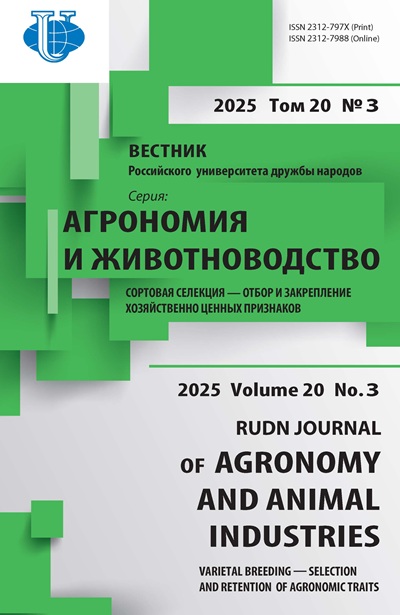ОЦЕНКА ЭФФЕКТИВНОСТИ ТЕХНОЛОГИИ ПОЛОСНОЙ ОБРАБОТКИ ПОЧВЫ
- Авторы: Борисенко ИБ1,2, Чамурлиев ОГ1, Чамурлиев ГО3, Мезникова МВ1
-
Учреждения:
- Волгоградский государственный аграрный университет
- Прикаспийский научно-исследовательский институт аридного земледелия
- Научно-исследовательский и проектный институт «Вид Проект»
- Выпуск: Том 13, № 3 (2018)
- Страницы: 194-206
- Раздел: Агротехнологии и мелиорация земель
- URL: https://agrojournal.rudn.ru/agronomy/article/view/19318
- DOI: https://doi.org/10.22363/2312-797X-2018-13-3-194-206
- ID: 19318
Цитировать
Полный текст
Аннотация
В статье рассмотрена технология чизелевания с позиции антропогенного воздействия на почву. Проанализировано влияние расстановки рабочих на технологический процесс обработки. Дана оценка эффективности ресурсосберегающей технологии глубокой обработки почвы при производстве пропашных культур на примере выращивания подсолнечника на территории Волгоградской области. Дана технико-экономическая оценка возделывания подсолнечника в зависимости от технологического процесса чизелевания. Определена конкурентоспособная технология основной обработки почвы. Анализ полученных данных показывает, что наибольшая площадь поперечного сечения пласта образуется при обработке почвы буровыми инструментами, поскольку рабочие органы расположены так, что они образуют зону непрерывного рыхления, соответственно, она оказывает наибольшее антропогенное воздействие. Полевые эксперименты также показали, что глубокие рыхлые ленты на глубину 0,25...0,35 м, чередующиеся с полосками без обработки, характеризуются положительными процессами. Необработанные площади становятся загущенными (более 1,3 г/см3), поэтому они создают менее благоприятные по сравнению с обработанными условия для развития некоторых видов многолетних сорняков. Исследования показали, что после основной обработки почвы на глубину 0,3 м с использованием технологии полосной обработки почвы сохранялось 69,67% стерни озимой пшеницы. Использование технологии полосной обработки почвы снижает затраты на топливо на 35,5% по сравнению с классическим обработкой и на 27,3% относительно минимальной технологии. Соответственно, стоимость заработной платы снижается на 37,5% по сравнению с классической схемой и на 24,8% по сравнению с минимальной технологией.
Об авторах
И Б Борисенко
Волгоградский государственный аграрный университет; Прикаспийский научно-исследовательский институт аридного земледелия
Автор, ответственный за переписку.
Email: borisenivan@yandex.ru
-
Университетский пр., 26, Волгоград, 400002, Российская Федерация; Северный квартал, с. Соленое Займище, Черноярский район, Астраханская область, 416251, Российская ФедерацияО Г Чамурлиев
Волгоградский государственный аграрный университет
Email: attika.ge@yandex.ru
-
Университетский пр., 26, Волгоград, 400002, Российская ФедерацияГ О Чамурлиев
Научно-исследовательский и проектный институт «Вид Проект»
Email: giorgostsamourlidis@mail.ru
-
Олимпийская ул., 1 корп. 2, Видное, Московская обл., 142703, Российская ФедерацияМ В Мезникова
Волгоградский государственный аграрный университет
Email: marina_roxette@mail.ru
-
Университетский пр., 26, Волгоград, 400002, Российская ФедерацияСписок литературы
- Шабаев А.И. Адаптивно-экологичские системы земледелия в агроландшафтах Поволжья / А.И. Шабаев. Саратов, 2003.
- Патент РФ № 1544634/27.08.15. Бюл. № 24. Борисенко И.Б., Борисенко П.И., Плескачев Ю.Н. [и др.]. Плуг-рыхлитель.
- Патент РФ № 2544950/20.03.15. Бюл. № 8. Борисенко И.Б., Плескачев Ю.Н., Соколова М.Н. / Орудие для регулируемой полосной глубокой обработки почвы.
- ГОСТ Р 52778-2007 Испытания сельскохозяйственной техники. Методы эксплуатационно-технологической оценки. Москва: Стандартинформ, 2008.
- Курманбаев С.К., Джаманова Г.И. Экологические основы организации защиты растений. Учебное пособие. Семей, 2016.
- Овчинников А.С. Регистр технологий производства зерновых, зернобобовых, крупяных и масличных культур в Волгоградской области / Сост. А.С. Овчинников, Ю.Н. Плескачев, И.Б. Борисенко, А.Н. Цепляев. Волгоград: ФГОУ ВПО «Волгоградский ГАУ», 2012.
Дополнительные файлы















